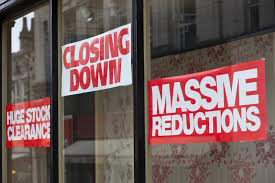Local Shopping

Local shopping centres and, now, high streets are becoming ghost towns as more and more shops and stores close. From the latest House of Fraser announcement of 31 of its 59 stores closing to Marks & Spencer closures and Poundworld facing administration following Toys R Us, the places where we shop are increasing marked with boarded up premises and only the most profitable big chain businesses moving in. Apparently 21,000 shop jobs have been lost in the first three months of 2018. Retail chains at all level are going under. For some time  there has been concern about how to resurrect smaller ‘out of town ‘shopping parades that face local businesses closing. Initiatives to attract new outside investment have generally got nowhere. Meanwhile the owners of shopping centres have been putting increasing pressure on retailers to pay them more rent. Landlord property companies such as Legal & General and Westfield and Land Securities, some of the biggest, are resisting government support through ’company voluntary arrangements” to reduce rent payments. The landlords argue that their companies represent pension and investment funds and need to maximize their profits. As a result more and more small businesses (and now some large) are closing down and shops boarded up.
there has been concern about how to resurrect smaller ‘out of town ‘shopping parades that face local businesses closing. Initiatives to attract new outside investment have generally got nowhere. Meanwhile the owners of shopping centres have been putting increasing pressure on retailers to pay them more rent. Landlord property companies such as Legal & General and Westfield and Land Securities, some of the biggest, are resisting government support through ’company voluntary arrangements” to reduce rent payments. The landlords argue that their companies represent pension and investment funds and need to maximize their profits. As a result more and more small businesses (and now some large) are closing down and shops boarded up.
But what about an alternative of local shopping facilities to serve local needs? Traditional corner shops and specialists such as flower shops and butchers in the past have had to survive against the move to the great all selling supermarkets. Locally our flower shop was priced out of the local Bramley shopping centre by the Berkshire owning property company raising the rents. A money lending shop moved in.
But imagine if a local community took over the management of a local parade of shops as a community “social enterprise”. In our neighbourhood for example the social enterprise could fix the rents on a community “non-personal profit” basis. Existing tenants need not be evicted but perhaps companies such as betting shops and money lending companies could be charged a higher rent to make up for what they extract from the local community. The flower shop could be moved back in at an affordable rent. A mums and tots centre could be set up, a local credit union shop blending in financial services advice including helping get cheap energy and communication deals, could take up a unit. A local garden produce market could be moved in as well as local crafts and sharing supplies, such as lending equipment and time exchanges. In other words, the real social and economic needs of the local economy could fill the premises and a social enterprise shopping parade would manage the premises and keep the rents low.
A local social enterprise shopping centre serving real local economic and social needs is the kind of alternative ‘base upwards’ and community participatory model that has been suggested for years in Catholic social teaching from Saint Pope John XXIII and more recently in Pope Emeritus Benedict’s Encyclicals through to the working models of “economy of communion” practiced worldwide in the Church by the Focolare movement. The “Economics of Communion” provides a real alternative. It now needs to be experimented with on a wider local scale.
*****************************************
